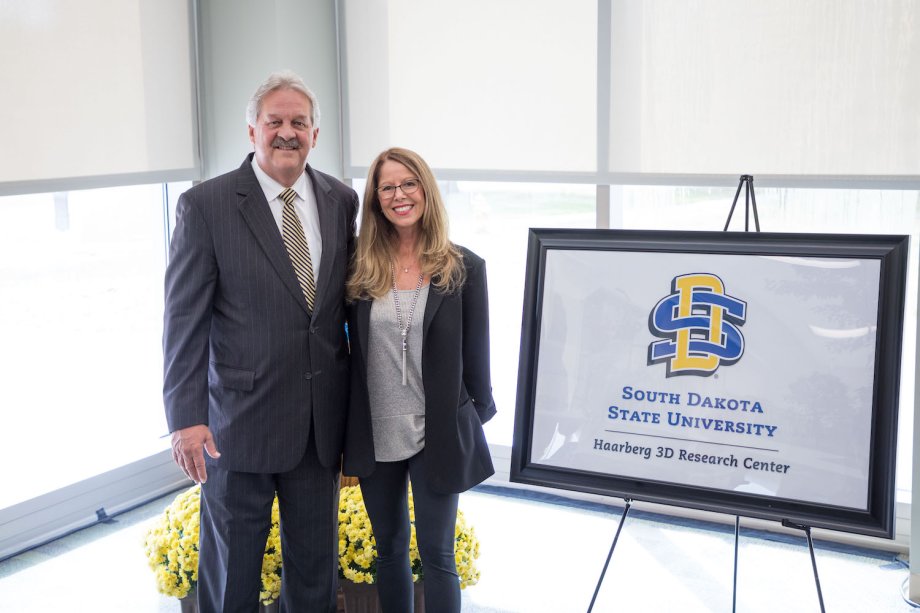
South Dakota State University's Haarberg Center for Drug, Disease and Delivery, housed in the College of Pharmacy and Allied Health Professions, has announced its second round of funding for research projects through the Haarberg 3D Center's Pilot Grant Program.
The Haarberg 3D Center is funded by the South Dakota Board of Regents, with a goal of advancing interdisciplinary research and research commercialization of biomedical technologies through university, industry and clinical collaborations. Recently, the center also received a $1.1 million gift from Kevin and Lorie Haarberg and a planned gift of $10 million.
"The goal of the pilot grant program is to fund promising pilot projects from the participating institutions," said Omathanu Perumal, director of the Haarberg Center for Drug, Disease and Delivery. "The funding helps researchers to generate the initial proof-of-concept and develop larger proposals for external funding."
Last year, four projects were funded through this program. This year, the center received 17 proposals from researchers at participating institutions. The proposals were evaluated by external reviewers, and the top-four ranked applications were recommended for funding by the center's steering committee.
The following were awarded one-year, $100,000 grants through the pilot program:
Saikat Basu, an assistant professor in South Dakota State University's Department of Mechanical Engineering, will develop and design a digital platform that will assess the targeted delivery of a wide range of nasal spray and oral inhaler products. The global market drug size for nasal spray and oral inhalers was valued at $17.5 billion in 2021 with expected growth to reach $38.4 billion by 2030. With Basu's platform, pharmaceutical companies will be able to test their formulations and devices by inputting their own product-specific numbers. The outputs will be predictive estimates for targeted drug delivery for a wide variety of respiratory diseases.
Rachel Willand-Charnley, an assistant professor in South Dakota State University's Department of Chemistry and Biochemistry, will study the role of sialic acid in evading the immune system by colon cancer cells. Willand-Charnley and her research team will explore the use of antibody-enzyme conjugate to sensitize colon cancer cells to the immune system. The outcomes from this work will help in developing new therapeutic approaches for colon cancer.
Pilar de la Puente, an assistant professor at the University of South Dakota and a scientist at Sanford Research, will look to study the effects of age on macrophage-influenced aberrant extracellular matrix (ECM) remodeling using a patient-derived 3D tissue culture model. ECM production is one of the major reasons why high-grade serous carcinoma (HGSC) is one of the most common types of "ovarian" cancers and one of the deadliest forms of cancer for women. Understanding the relationship that age plays in ECM remodeling is important but presently has not been well defined. Puente's research project will look to fill in these knowledge gaps while also developing novel technologies to further cancer research. The 3D tissue culture model has been patented, and findings from this work will help identify new therapeutic targets for cancer.
Sunil Mor, an assistant professor in South Dakota State University's Department of Veterinary and Biomedical Sciences, will lead a team of researchers who will develop and test a novel viral vectored vaccine to protect pigs against porcine reproductive and respiratory syndrome (PRRS). The development of a vaccine would have considerable value as PRRS is an endemic disease that creates massive economic losses to the world swine industry. The successful outcome of this project would be the development of a patented PRRS vaccine product.
Each of the aforementioned research proposals have a significant technology development component that aligns with the Haarberg 3D Center's mission of advancing research commercialization of biomedical technologies.
Funding from the BOR and the Haarberg’s helps to strengthen infrastructure to support and grow the biomedical research in the state.
- Contact:
- Telephone number: 605-688-6161
Republishing
You may republish SDSU News Center articles for free, online or in print. Questions? Contact us at sdsu.news@sdstate.edu or 605-688-6161.

